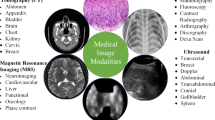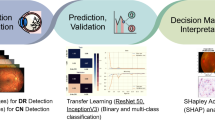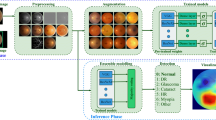Abstract
Diabetes causes DR. Diabetes duration influences retinopathy development. The retinal vein weakening may have no side effects or a little eyesight impairment at initially. Blindness may occur. DR intervention and treatment need early clinical indications. Thus, frequent eye examinations must guide patients to a doctor for a full eye inspection and therapy to avoid irreversible vision loss. This work develops a machine learning-based optical image-based data classification method for diabetic retinopathy identification. OCT analyses the retinal picture and the ensemble pulse coupled filtering and green histogram channel equalization-based adaptive filtering segment this picture for blood vessel characterization. CenterResnet-50 classifies images for color fundus detection. Classification accuracy, sensitivity, specificity, AUC, and ROC curves were examined for various optical retina pictures. The proposed method has 98% classification accuracy, 67% sensitivity, 73% specificity, and 63% AUC.










Similar content being viewed by others
Data availability
All the data’s available in the manuscript.
References
AbdelMaksoud, E., Barakat, S., Elmogy, M.: A computer-aided diagnosis system for detecting various diabetic retinopathy grades based on a hybrid deep learning technique. Med. Biol. Eng. Comput. 60(7), 2015–2038 (2022)
Agarwal, S., Bhat, A.: A survey on recent developments in diabetic retinopathy detection through integration of deep learning. Multimed. Tools Appl. 82(11), 17321–17351 (2023)
Baffa, M., Gomes Martins, J. V., Martins Coelho, A., Cezar Felipe, J.: Radiomic-based features for diabetic retinopathy early detection using deep neural networks. Available at SSRN 4168544 (2021)
Bilal, A., Zhu, L., Deng, A., Lu, H., Wu, N.: AI-based automatic detection and classification of diabetic retinopathy using U-Net and deep learning. Symmetry 14(7), 1427 (2022)
Das, D., Biswas, S.K., Bandyopadhyay, S.: A critical review on diagnosis of diabetic retinopathy using machine learning and deep learning. Multimed. Tools Appl. 81(18), 25613–25655 (2022)
Dong, B., Wang, X., Qiang, X., Du, F., Gao, L., Wu, Q., Dai, C.: A multi-branch convolutional neural network for screening and staging of diabetic retinopathy based on wide-field optical coherence tomography angiography. IRBM 43(6), 614–620 (2022)
Gundluru, N., Rajput, D. S., Lakshmanna, K., Kaluri, R., Shorfuzzaman, M., Uddin, M., & Rahman Khan, M. A.: Enhancement of detection of diabetic retinopathy using Harris hawks optimization with deep learning model. Computational Intelligence and Neuroscience. (2022)
Jena, M., Mishra, D., Mishra, S. P., Mallick, P. K., Kumar, S.: Exploring the parametric impact on a deep learning model and proposal of a 2-Branch CNN for diabetic retinopathy classification with case study in IoT-Blockchain based smart healthcare system. Informatica 46(2), (2022)
Jiwani, N., Gupta, K., Afreen, N.: A convolutional neural network approach for diabetic retinopathy classification. In: 2022 IEEE 11th International Conference on Communication Systems and Network Technologies (CSNT) (pp. 357–361). IEEE. (2022)
Khalili Pour, E., Rezaee, K., Azimi, H., Mirshahvalad, S.M., Jafari, B., Fadakar, K., Riazi Esfahani, M.: Automated machine learning–based classification of proliferative and non-proliferative diabetic retinopathy using optical coherence tomography angiography vascular density maps. Graefe’s Archive Clin. Exp. Ophthalmol. 261(2), 391–399 (2023)
Nadeem, M.W., Goh, H.G., Hussain, M., Liew, S.Y., Andonovic, I., Khan, M.A.: Deep learning for diabetic retinopathy analysis: a review, research challenges, and future directions. Sensors 22(18), 6780 (2022)
Selvachandran, G., Quek, S.G., Paramesran, R., Ding, W., Son, L.H.: Developments in the detection of diabetic retinopathy: A state-of-the-art review of computer-aided diagnosis and machine learning methods. Artif. Intell. Rev. 56(2), 915–964 (2023)
Shelke, S., Subasi, A.: Detection and classification of diabetic retinopathy lesions using deep learning. In Applications of Artificial Intelligence in Medical Imaging (pp. 241–264). Academic Press, (2023)
Srivastava, A., Singh, G., Shukla, M. K., & Majumdar, R.: Covid-19 and diabetic retinopathy (Dr) detection using Ai & deep learning. In: 2022 3rd International Conference on Computation, Automation and Knowledge Management (ICCAKM) (pp. 1–9). IEEE. (2022)
Srinivasan, S., Nagarnaidu Rajaperumal, R., Mathivanan, S.K., Jayagopal, P., Krishnamoorthy, S., Kardy, S.: Detection and grade classification of diabetic retinopathy and adult vitelliform macular dystrophy based on ophthalmoscopy images. Electronics 12(4), 862 (2023)
Uppamma, P., & Bhattacharya, S.: Deep learning and medical image processing techniques for diabetic retinopathy: a survey of applications, challenges, and future trends. Journal of Healthcare Engineering, (2023)
Venkaiahppalaswamy, B., Reddy, P.P., Batha, S.: Hybrid deep learning approaches for the detection of diabetic retinopathy using optimized wavelet based model. Biomed. Signal Process. Control 79, 104146 (2023)
Zang, P., Hormel, T.T., Wang, X., Tsuboi, K., Huang, D., Hwang, T.S., Jia, Y.: A diabetic retinopathy classification framework based on deep-learning analysis of OCT angiography. Transl. vis. Sci. Technol 11(7), 10–10 (2022)
Funding
This research not received any fund.
Author information
Authors and Affiliations
Contributions
SM: Conceived and design the analysis. Writing- Original draft preparation. SS: Collecting the Data, CSR: Contributed data and analysis stools, SG: Performed and analysis, MMU: Performed and analysis, NK: Wrote the Paper. Editing and Figure Design.
Corresponding author
Ethics declarations
Conflict of interest
The authors declare that they have no known competing financial interests or personal relationships that could have appeared to influence the work reported in this paper.
Ethical approval
This article does not contain any studies with animals performed by any of the authors.
Additional information
Publisher's Note
Springer Nature remains neutral with regard to jurisdictional claims in published maps and institutional affiliations.
Rights and permissions
Springer Nature or its licensor (e.g. a society or other partner) holds exclusive rights to this article under a publishing agreement with the author(s) or other rightsholder(s); author self-archiving of the accepted manuscript version of this article is solely governed by the terms of such publishing agreement and applicable law.
About this article
Cite this article
Malik, S., Srinivasan, S., Rajora, C.S. et al. Optical system based data classification for diabetes retinopathy detection using machine language with artificial intelligence. Opt Quant Electron 55, 896 (2023). https://doi.org/10.1007/s11082-023-05193-x
Received:
Accepted:
Published:
DOI: https://doi.org/10.1007/s11082-023-05193-x




